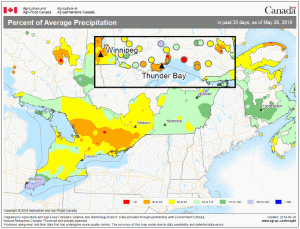Northeastern:
>There is currently limited alfalfa regrowth in many areas thanks to a cool, slow start to the spring. Winterkill has been an issue in Temiskaming due to drowning out after an early thaw left standing water in many field.
>Timing is variable across the region: in Algoma forages seem delayed by 2-3 weeks, while Cochrane District is experiencing more normal timing for green-up. The main challenge will be grasses getting ahead of legume development in areas where green-up and growth have been slower than normal.
>Estimates suggest 1st cut hay might begin as early as next week in Nipissing, and the 2nd week of June in Temiskaming.
>Algoma, Manitoulin, and Temiskaming had average rainfall in May, while the rest of the region received 60-85% of average precipitation, and some parts of Cochrane District received 40-85% of average rainfall.
Northwestern:
>Most alfalfa stands overwintered well; however those on heavy soils and in low-lying areas may have suffered winter injury.
>Although there were cool conditions earlier in the month, a lot of GDDs accumulated rapidly in the last two weeks of May.
>Alfalfa green-up and growth does not seem as delayed as in other parts of the province: estimates suggest the first cut will be between the first and third week of June, which is at most one week delayed from normal. The main challenge will be grasses getting ahead of legume development.
>Rainy River District had average amounts of precipitation in May, while the agricultural region of Kenora District received 60-85% of average rainfall, and Thunder Bay District had 40-60% of average precipitation.

Optimal dairy quality in first cut alfalfa occurs between 330-389 GDDs.

Percent of average precipitation received in May 2018
Source : Field Crop News